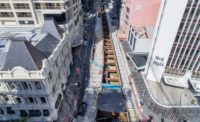Auckland’s landmark City Rail Link project is making good progress in its early stages, with two construction consortiums beginning the first phase in the city's downtown. But costs could soar, ministers have warned. The original price estimate of NZ$1.8 billion, or US$1.2 billion, looks set to escalate to between NZ$2.8 billion ($1.9 billion) and NZ$3.4 billion ($2.2 billion), according to Finance Minister Steven Joyce and Transport Minister Simon Bridges. The news follows completion of more detailed design work.
Meanwhile, progress continues on sinking the shafts for associated early works, which include the construction of a new stormwater pipe under Albert Street in the city’s central business district, replacing an existing structure in advance of the main tunneling works. The thrust and reception shafts for the pipejacking operation are now well advanced. Soldier piles, timber lagging and precast units are being installed, according to Andrew Willis, Harker Underground’s pipejack manager for Auckland City Rail Link (CRL), Enabling Works Contract 2, which is part of the Connectus joint venture. Last month, he was preparing for delivery of the Akkerman machines, ready to drive the 2.2-meter-dia horizontal works for the stormwater diversion.
Eight months into the project, Scott Elwarth, Auckland Transport’s construction manager, is pleased. “The shafts are largely completed now,” he said. “We’ve got past the obstacles posed by the utilities, and we can see the construction of the temporary station at Britomart [the CBD terminus] going according to plan. We have shut down the [Central Post Office], and there’s to be a temporary facility in Commerce Street.”
Part of the contract involves diverting an existing stormwater tunnel. The tunnel was constructed in the mid-1930s and runs down the center of Albert Street at depths reaching 18 meters. The diversion will be constructed by pipejacking a 2.0-m to 2.2-m pipeline along the eastern side of Albert Street between Swanson Street and Wellesley Street. There will be four shaft locations at the intersections of Swanson Street, Victoria Street and Wellesley Street. The total length of the stormwater main is 520 m.
On the route, a 150-tonne Soilmec SR100 continuous flight auger (CFA) piling rig, claimed to be the first of its kind in New Zealand, is busy on piling works adjacent to the city’s high-rise buildings. The rig is well travelled, having completed projects in Copenhagen, Denmark, and Oman. The machine will install a total of 375 piles, which are required for a challenging deep-excavation exercise under Albert Street in advance of cut-and-cover works for the CRL's tunnels. The 762-millimeter-dia piles will form a retaining wall, enabling contractor McConnell Dowell to excavate for the construction of the CRL's tunnels and stations. The piles are being driven in the East Coast Bays foundation.
“It’s a big rig and very powerful,” says Marco Lucchi, Trevi Construction’s project manager. The rig’s 480-kW power source gives the unit 452-kNm of torque. “It’s more than capable of this task. The only restraints on its progress are the restrictions on working close to buildings, traffic constraints and those of working in a busy city-center environment. Progress could certainly be better, but we’re working in a very congested area. This machine could double the productivity in an open area. But three to four piles a day means we will meet our target and program.”
Progress also is determined by vehicular access to the site. Two to three concrete trucks are needed per pile, along with another three to five for spoil disposal and casing and rebar-cage deliveries. “It’s a logistical challenge,” says Lucchi.
The project consists of an electrified, double-track rail tunnel underneath Auckland's city center, running for some 3.5 km between Britomart Transport Centre and the Western Line, connecting slightly west of Mount Eden Railway Station. Designed for 30,000 people at peak hours–double the current number—while slashing travel times across the rail network, CRL aims to help free up disjointed rail travel in New Zealand's most populous city.




Post a comment to this article
Report Abusive Comment